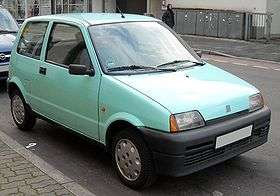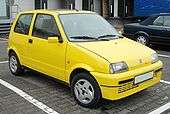Fiat Cinquecento
| Fiat Cinquecento | |
|---|---|
 | |
| Overview | |
| Manufacturer | Fiat |
| Production | 1991–1998 |
| Assembly | Tychy, Poland |
| Body and chassis | |
| Class | City car (A) |
| Body style | 3-door hatchback |
| Layout | Front-engine, front-wheel-drive |
| Powertrain | |
| Engine | |
| Dimensions | |
| Wheelbase | 2,200 mm (86.6 in)[1] |
| Length |
3,230 mm (127.2 in) 3,226 mm (127.0 in) (Sporting) |
| Width |
1,490 mm (58.7 in) 1,486 mm (58.5 in) (Sporting) |
| Height | 1,435 mm (56.5 in) |
| Kerb weight | 675–727 kg (1,488–1,603 lb) |
| Chronology | |
| Predecessor | Fiat 126 |
| Successor | Fiat Seicento |

The Fiat Cinquecento (Type 170) (/ˌtʃɪŋkwəˈtʃɛntoʊ/; Italian pronunciation: [ˌtʃiŋkweˈtʃɛnto]) is a city car, launched by Fiat in December 1991, to replace the Fiat 126. It was the first Fiat model to be solely manufactured in the FSM plant in Tychy, Poland, which had been sold to Fiat by the Polish state, and where production of the Polish variant of the Fiat 126, the Polski Fiat 126p, was still running.
However, the right-hand drive Cinquecento for the British market was not launched for another 18 months, going on sale there in June 1993, where at the time it was one of the few city cars sold there. The Renault Twingo, launched around the same time as the Cinquecento, was not sold in Britain as Renault did not feel that there was sufficient demand for that type of car there at the time. However, by the end of the 1990s, city cars in Britain - and indeed most of the rest of Europe - were enjoying a rise in popularity, with the arrival of new city cars including the Ford Ka, Seat Arosa and Volkswagen Lupo.
Production of the Cinquecento ended in early 1998, when it was replaced by the Seicento. Despite its name, its lowest displacement was 704 cc. The Cinquecento was available in one body style only, a small, angular 3-door hatchback, with a favourable drag coefficient of only 0.33 that bore similarities to the Lancia Y10.
It featured several advances compared to older Fiat city cars, including independent suspension both in the front and in the rear similar to the Fiat Tipo, front disc brakes, side impact bars along with crumple zones incorporated in the design and galvanized body panels to fend off corrosion.
Steering was by rack and pinion, and although power steering was never offered, the car could be ordered with a number of extras, including central locking, power windows, sunroof (or full-length retractable canvas roof in the Soleil version) and even air conditioning.[2]
Engines
Unlike the rear-wheel drive 126, the Cinquecento was a front-wheel-drive car. Whereas the 126 had a rear-mounted engine, the Cinquecento now featured a front-mounted engine.
It was initially available with two engine choices, with the 1.1 L FIRE or "sporting" joining the lineup later. Interestingly, while the 704 cc engine was mounted longitudinally, the bigger units were fitted transversely, making the little Fiat one of the few cars in the world available with both configurations at the same time.[2][3]
704 cc
The smallest engine, intended for sale in Poland only, was a 704 cc OHV two-cylinder unit, delivering 31 metric horsepower (23 kW) or 30 metric horsepower (22 kW) with catalyst. Cinquecento inherited this unit from the 126p BIS, an evolution of the 126p which was cancelled when the Cinquecento production started.
In order to be fitted in the front-wheel drive Cinquecento, it underwent a major refurbishment (although the engine still employed a carburettor), which resulted, among other changes, in the crankshaft revolving in the opposite direction than in the 126p BIS![2][3]
903/899 cc
The bigger engine was the 903 cc 40 PS (29 kW; 39 hp) version of the veteran Fiat 100 OHV four-cylinder engine, which saw service in many small Fiat models, starting with Fiat 850. (This engine dates back to the initial 633 cc unit as introduced in the 1955 FIAT 600.)
It was fitted with single point fuel injection and was the base engine in most markets. Due to fiscal limitations, the displacement of this unit was limited to 899 cc in 1993, with a slight reduction of output, now producing 39 PS (29 kW; 38 hp).[2][3] This engine is derived from that used in the Fiat 127.
While it still retains OHV chain drive pushrod layout it now has hydraulic tappets. Also now uses twin coil distributorless ignition.
1.1 FIRE (Sporting)


In 1994, Fiat introduced the Cinquecento Sporting, featuring the 1108 cc SOHC FIRE 54 PS (40 kW; 53 hp) engine from the entry-level Punto of the same era, mated to a close-ratio gearbox. Other additions were a drop in standard ride height, front anti-roll bar, 13" alloy wheels, plus colour-coded bumpers and mirrors. The interior saw a tachometer added, along with sports seats, red seatbelts and a leather steering wheel and gear knob.
It is the Sporting model which gave birth to a rallying trophy and a Group A Kit-Car version.[2][3]
Elettra
From 1992–1996, Fiat also produced and sold an electric variant of the Cinquecento called the Elettra. The car was offered with either a lead-acid or NiCd batterypack, providing a ranges of 62 mi (100 km) and 93 mi (150 km) respectively. Unlike purpose built electric cars, the Cinquecento Elettra used two battery packs, one in the engine bay and one under the rear seats, replacing the fuel tank.
Although selling for 140,000 francs (~US$23,000), the Cinquecento Elettra enjoyed relative popularity in Italy, France and Switzerland.[4]
Abarth
Fiat offered optional extras from the factory labelled with the Abarth name. The Abarth extras for the Cinquecento consisted of cosmetic changes only. A front apron with fitted fog lights, a rear apron, side skirts and a rear spoiler with a fitted 3rd brake light. There were also a set of 13" Speedline 5-spoke alloys wheels available, instead of the standard Sporting alloys.
Unlike true Abarth models, there were no engine upgrades available from the factory and the car could not be purchased as a whole separate model. The Abarth parts were to be added by the purchaser at the time of ordering, hence why it is common to see cars with only some of the Abarth extras.

Concepts
During the 1990s, a number of concept cars based on the Fiat Cinquecento were developed, by a number of design houses, including one that featured half of the car's interior and a running board to place bikes.
Another of these designs was the Lucciola, a proposal for a new Cinquecento by Giorgetto Giugiaro. However, instead of the car becoming the next small Fiat city car, a version of the design ended up being put into production by the South Korean Daewoo Motor, as their Matiz.
In popular culture
A Fiat Cinquecento appears in several episodes of the British sitcom The Inbetweeners, in which main character Simon Cooper owns a yellow, fictional model known as a Fiat Cinquecento 'Hawaii' (the car used in filming is an 899cc model). Its appearance and features (including a tape deck and a replacement red side door) are frequently ridiculed by the lads. In March 2011, the car was listed on eBay, in order to raise money for Red Nose Day 2011.
Over the course of the series, the car ends up with the following misfortunes:
- Simon driving the car into the middle of a slow funeral procession (Thorpe Park).
- Main character Jay Cartwright tearing off the passenger door when Simon is trying to park it at Thorpe Park (Thorpe Park).
- The Happy Foundation bus trashing the car after main character Will McKenzie insults them on the Nemesis Inferno (Thorpe Park).
- Main character Neil Sutherland committing foreplay with a punk, causing the seats to go all damp (Caravan Club).
- The car getting clamped after Simon parks in front of a no 'parking' sign by a warehouse (A Night Out in London).
- An angry deliveryman beating the car after he missed all his work placements, because of Simon's clamped car blocking his van (A Night Out in London).
- The car drifting into a lake after Jay fails to apply the handbrake (The Camping Trip).
In the short lived American remake of the show, the car was replaced with a Ford Festiva, with the replacement door being coloured blue instead of red.
References
- ↑ "Fiat Cinquecento". carfolio.com. Retrieved 2007-10-11.
- 1 2 3 4 5 "Fiat Cinquecento". carsfromitaly.com. Archived from the original on 2005-04-01. Retrieved 2006-08-26.
- 1 2 3 4 "Samochody Świata" (in Polish) (3). 1992: 146–147. Nr indeksu 371651.
- ↑ "Elektromobil FIAT Cinquecento Elettra" (in Czech). Archived from the original on 23 November 2010. Retrieved 12 May 2011.
External links
| Wikimedia Commons has media related to Fiat Cinquecento. |
| « previous — Fiat car timeline (Europe), 1980s–present | |||||||||||||||||||||||||||||||||||||||
|---|---|---|---|---|---|---|---|---|---|---|---|---|---|---|---|---|---|---|---|---|---|---|---|---|---|---|---|---|---|---|---|---|---|---|---|---|---|---|---|
| Type | 1980s | 1990s | 2000s | 2010s | |||||||||||||||||||||||||||||||||||
| 0 | 1 | 2 | 3 | 4 | 5 | 6 | 7 | 8 | 9 | 0 | 1 | 2 | 3 | 4 | 5 | 6 | 7 | 8 | 9 | 0 | 1 | 2 | 3 | 4 | 5 | 6 | 7 | 8 | 9 | 0 | 1 | 2 | 3 | 4 | 5 | 6 | 7 | ||
| City car | 126 | Cinquecento | Seicento / 600 | ||||||||||||||||||||||||||||||||||||
| 500 | |||||||||||||||||||||||||||||||||||||||
| Panda I | Panda II | Panda III | |||||||||||||||||||||||||||||||||||||
| Supermini | Hatch | 127 | Punto I | Punto II | |||||||||||||||||||||||||||||||||||
| Uno | Palio | Grande Punto | Punto Evo | Punto | |||||||||||||||||||||||||||||||||||
| Saloon | Duna | Siena | Albea | ||||||||||||||||||||||||||||||||||||
| Small family car | Hatch | Ritmo | Tipo | Bravo I / Brava | Stilo | Bravo II | Tipo | ||||||||||||||||||||||||||||||||
| Saloon | 128 | ||||||||||||||||||||||||||||||||||||||
| 131 | Regata | Tempra | Marea | Linea | Tipo | ||||||||||||||||||||||||||||||||||
| Large family car | 132 | Argenta | Croma I | Croma II | |||||||||||||||||||||||||||||||||||
| Cabriolet | Ritmo Cabrio | Punto Cabrio | 500C | ||||||||||||||||||||||||||||||||||||
| Coupé | Coupé | ||||||||||||||||||||||||||||||||||||||
| Spider | Spidereuropa | Barchetta | Barchetta | 124 Spider | |||||||||||||||||||||||||||||||||||
| Sports car | X1/9 | ||||||||||||||||||||||||||||||||||||||
| LCV/LAV | Fiorino I | Fiorino II | Fiorino III / Qubo | ||||||||||||||||||||||||||||||||||||
| Doblò I | Doblò II | ||||||||||||||||||||||||||||||||||||||
| Mini SUV | Sedici | 500X | |||||||||||||||||||||||||||||||||||||
| Mini MPV | Idea | 500L | |||||||||||||||||||||||||||||||||||||
| Compact MPV | Multipla | ||||||||||||||||||||||||||||||||||||||
| Large MPV | Ulysse I | Ulysse II | Freemont | ||||||||||||||||||||||||||||||||||||
| Van | Daily | Scudo I | Scudo II | Talento | |||||||||||||||||||||||||||||||||||
| Ducato I | Ducato II | Ducato III | |||||||||||||||||||||||||||||||||||||
| Mini pickup | Strada | ||||||||||||||||||||||||||||||||||||||
| Pickup | Fullback | ||||||||||||||||||||||||||||||||||||||
| Off-road | Campagnola (1107) | ||||||||||||||||||||||||||||||||||||||
| Legend |
| ||||||||||||||||||||||||||||||||||||||